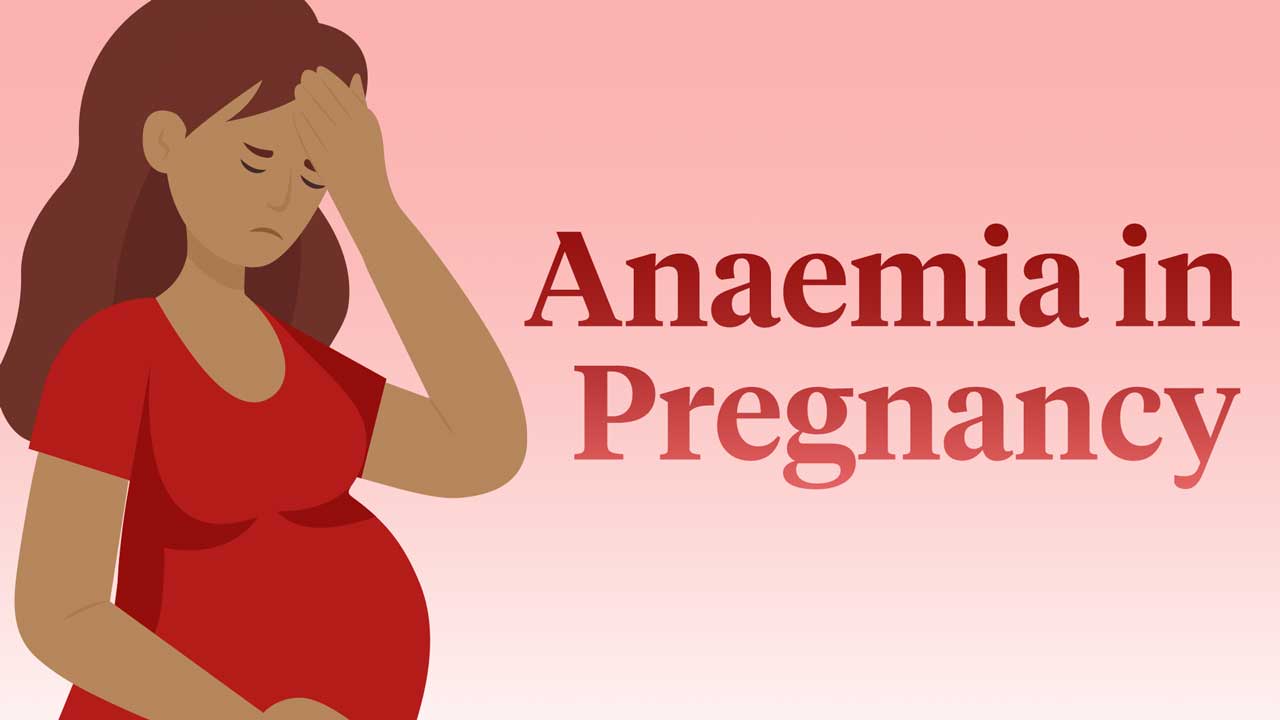Anaemia in pregnancy is a significant health problem that affects over 38% of pregnant people worldwide and 25% of pregnant people in Australia (Frayne & Pinchon 2019).
All pregnant people are at risk of anaemia due to increased iron demands as their pregnancy progresses. Furthermore, all pregnant people require more iron and folic acid than usual (Frayne & Pinchon 2019).
Anaemia is most commonly caused by a lack of iron, but can also arise from less common causes such as nutritional deficiencies, haemoglobinopathies, infectious and chronic diseases and very rarely, malignancy (Frayne & Pinchon 2019).
Healthy Haemoglobin Levels
As defined by the World Health Organisation, the mean minimum normal haemoglobin concentration in healthy pregnant people is 110 mg/dL in the first half of pregnancy and 105 mg/dL in the second (ALEC 2025).
If these levels aren’t being met, it’s likely that one of the following three types of anaemia is the cause:
- Iron-deficiency anaemia
- Folate-deficiency anaemia
- Vitamin B12 deficiency.
(Uscher 2024)
Iron-Deficiency Anaemia
Iron-deficiency anaemia is by far the most common cause of anaemia in pregnancy. It develops when the body doesn't have enough iron to produce adequate amounts of haemoglobin, which means that the blood cannot carry enough oxygen to the tissues throughout the body (Frayne & Pinchon 2019).
Iron-deficiency anaemia is thought to account for approximately 50% of cases worldwide, yet to date, very few studies have determined the incidence of this form of anaemia among pregnant people in Australia (Frayne & Pinchon 2019).
Folate-Deficiency Anaemia

Folate occurs naturally in foods such as green leafy vegetables. It’s needed by the body to produce healthy red blood cells. Many people require extra folate during pregnancy, and if they don’t get enough from their diet, anaemia may develop. Lack of folate during pregnancy is also known to contribute to certain birth defects such as neural tube abnormalities (spina bifida) and low birth weight, which is why most people are offered folic acid supplements during their pregnancy (Uscher 2024).
Vitamin B12 Deficiency
Similarly, a lack of vitamin B12, which is needed to form healthy red blood cells, can also cause anaemia. This is most commonly seen in people who have vegan or vegetarian diets, as vitamin B12 is mostly found in meat and dairy products. As with folate deficiency, a lack of vitamin B12 is also linked with neural tube abnormalities and can increase the risk of pre-term labour (Uscher 2024).
Early Diagnosis and Risk Detection of Anaemia in Pregnancy
Reducing the risk of iron-deficiency anaemia is dependent on early diagnosis, along with risk detection and early management. Ideally, this should start during pre-conceptual care or early antenatal care. Established risk factors for developing anaemia in pregnancy include:
- Being under 18 years of age
- Multiparity
- Previous iron deficiency
- Shortened pregnancy interval
- Disadvantaged socioeconomic status
- Not eating enough iron-rich foods
- Non-white ethnic origin
- Haemoglobinopathy
- Chronic blood loss
- Parasitic disease
- Morning sickness with excessive vomiting.
(Frayne & Pinchon 2019; Uscher 2024)
Frayne and Pinchon (2019) note that it’s important to identify people who are at increased risk of the effects of anaemia. For example, those who:
- Are at greater risk of haemorrhage at birth
- Have bleeding disorders
- Are on anticoagulation therapy
- For religious or cultural reasons, might decline blood products.
Symptoms of Anaemia During Pregnancy
Many of the symptoms of anaemia are not immediately obvious. However, as haemoglobin levels continue to fall, some or all of the following symptoms can occur:
- Pale skin, lips and nails
- Fatigue or weakness
- Dizziness
- Shortness of breath
- Rapid heart rate
- Difficulty concentrating.
(Uscher 2024)

The Risks of Anaemia in Pregnancy
Left untreated, iron-deficiency anaemia during pregnancy can increase the risk of:
- A preterm or low-birth-weight baby
- The need for a blood transfusion
- Neonatal anaemia
- Developmental delays in childhood.
(Uscher 2024)
Low iron during pregnancy, especially in the third trimester, can also have a detrimental effect on the neurodevelopment of the fetus. However, recent research exploring supplementation with iron during pregnancy did not seem to influence outcomes, and further research is needed in this area (Janbek et al. 2019).
Again, it’s been suggested that anaemia and iron deficiency may contribute to post-partum depression in at-risk people, but further studies are needed to confirm a positive association (Wassef et al. 2018).
Iron Supplements
Too much iron can be just as detrimental to health as too little, and at present, routine administration of iron supplements in pregnancy is not recommended due of concerns regarding lack of evidence to support improved clinical outcomes (Frayne and Pinchon 2019).
Oral iron supplements may cause adverse gastrointestinal effects such as constipation and nausea. Similarly, intramuscular or intravenous iron may have adverse effects such as allergic reactions (ALEC 2025).
As per current practice, full blood screening occurs at the first antenatal visit and again at 28 weeks gestation, followed by further investigations and treatment as required if anaemia is detected (ALEC 2025).
Supplementing with Folate
Adequate folate levels are especially important in early pregnancy to prevent neural tube defects. All people should take a folate supplement in the form of folic acid from the time they are trying to conceive and during the first three months of pregnancy (ALEC 2025).
The Importance of Health Education
Physiological anaemia, sometimes called dilutional anaemia, is a normal process associated with pregnancy, but all people should be offered screening for iron deficiency and lack of folate while pregnant. In addition to routine clinical screening, pregnant patients themselves have an important role to play in ensuring they maintain adequate iron levels by eating a healthy, well-rounded diet.
This is why health education also plays such an important role in preventing anaemia in pregnancy. Simple nutritional education about the consumption of iron-rich foods and iron and folate supplementation is recommended both pre-conceptually and antenatally so that patients can play an active role in maintaining optimal health for themselves and their baby.
Test Your Knowledge
Question 1 of 3
What is the minimum normal haemoglobin concentration in the second half of pregnancy?
Topics
References
- Australian Living Evidence Collaboration 2025, Australian Pregnancy Care Guidelines, Australian Government, viewed 12 May 2025, https://app.magicapp.org/?language=en#/guideline/jm83RE
- Frayne, J & Pinchon, D 2019, ‘Anaemia in Pregnancy’, Australian Journal of General Practice, vol. 48, no. 3, viewed 12 May 2025, https://www1.racgp.org.au/ajgp/2019/march/anaemia-in-pregnancy
- Janbek, J, Sarki, M, Specht, I & Heitmann, B 2019, ‘A Systematic Literature Review of the Relation Between Iron Status/Anemia in Pregnancy and Offspring Neurodevelopment’, European Journal of Clinical Nutrition, vol. 73, no. 12, viewed 12 May 2025, https://www.nature.com/articles/s41430-019-0400-6
- Uscher, J 2024, Anemia in Pregnancy, WebMD, viewed 12 May 2025, https://www.webmd.com/baby/anemia-in-pregnancy
- Wassef, A, Nguyen, Q & St-André, M 2018, ‘Anaemia and Depletion of Iron Stores as Risk Factors for Postpartum Depression: A Literature Review’, Journal of Psychosomatic Obstetrics & Gynecology, vol. 40, no. 1, viewed 12 May 2025, https://www.tandfonline.com/doi/full/10.1080/0167482X.2018.1427725
 New
New 
